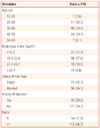Abstract
Objective
We wanted to evaluate the prevalence of dysmenorrhea and premenstrual syndrome (PMS) among the career women of Bucheon City and their knowledge of and ability to seek treatment regarding their dysmenorrhea and premenstrual syndrome.
Methods
A questionnaire survey regarding premenstrual symptoms was conducted for 289 career women. The cycle of menstruation, the regularity, the amount of menstruation and the intensity of dysmenorrheal were assessed and the symptoms were classified according to their intensity and persistence. Women's awareness of PMS and the physician consultations were also evaluated.
Results
The approximate prevalence of PMS by the World Health Organization's International Classification of Disease (ICD-10) and the American College of Obstetrics and Gynecology criteria was 74% and 38%, respectively. The predominant symptoms of PMS were abdominal bloating, anger, weight gain, sleep disturbance, attention deficit, drowsiness, nausea and vomiting. PMS was significantly associated with the large amount of menstruation (P = 0.017) and there was no significant relation with the cycle, the severity of dysmenorrhea and the use of analgesics. Most of the women (94.1%) had no knowledge regarding the terminology pertaining to PMS and premenstrual dysphoric disorder.
Conclusion
PMS occurs frequently and it has a significant impact on the activity of career women. However, career women have little knowledge about PMS and they only infrequently consult their physicians. Physicians should educate and inform career women about PMS and this can help to increase the quality of life of these women.
Figures and Tables
References
1. Reid RL, Yen SS. The premenstrual syndrome. Clin Obstet Gynecol. 1983. 26:710–718.
2. Janca A, Hiller W. ICD-10 checklists: a tool for clinicians' use of the ICD-10 classification of mental and behavioral disorders. Compr Psychiatry. 1996. 37:180–187.
3. American Psychiatric Association. Diagnostic and statistical manual of mental disorders: DSM-III-R. 1987. 3rd ed. Washington (DC): American Psychiatric Association.
4. American Psychiatric Association. Diagnostic and statistical manual of mental disorders: DSM-IV. 1994. 4th ed. Washington (DC): American Psychiatric Association.
5. American College of Obstetricians and Gynecologists. Premenstrual syndrome. ACOG Practice Bulletin No. 15. 2000. Washington (DC): American College of Obstetricians and Gynecologists;1–9.
6. Kim TH. Premenstrual syndrome. J Soonchunhyang Med Sci. 2009. 14:79–84.
7. Lee SH. Premenstrual syndrome & premenstrual dysphoric disorder. J Korean Acad Fam Med. 2001. 22:761–772.
8. Lew YM, Joe SH. Premenstrual symptom patterns and coping style in women with premenstrual change. J Korean Neuropsychiatr Assoc. 2000. 39:1061–1071.
9. Steiner M, Pearlstein T. Premenstrual dysphoria and the serotonin system: pathophysiology and treatment. J Clin Psychiatry. 2000. 61:Suppl 12. 17–21.
10. Haskett RF, De Longis A, Kessler RC. Premenstrual dysphoria: a community survey. Presented at the 140th Annual Meeting of the American Psychiatric Association. 1987. 1987 May 9-15; Chicago. Washington (DC): APA Press.
11. Rivera-Tovar AD, Frank E. Late luteal phase dysphoric disorder in young women. Am J Psychiatry. 1990. 147:1634–1636.
12. Jeong BS, Lee C, Lee JH, Seo MK, Han OS, Kim CY. Prevalence of premensttual syndrome and premenstrual dysphoric. J Korean Neuropsychiatr Assoc. 2001. 40:551–558.
13. Park YH, Jeong BS, Kim CY, Lee C. Prevalence of premenstrual dysphoric disorder and occupational function in a nurse group. J Korean Neuropsychiatr Assoc. 2001. 40:832–841.
14. Park JW, Kim JS, Lee KY, Park TJ, Kim SH. Factors associated with premenstrual syndrome in high school students. Korean J Fam Med. 2009. 30:710–716.
15. Kim J, Ryu SY. The prevalence of premenstrual syndrome and its related factors among high school girls. J Korean Soc Matern Child Health. 2006. 10:11–20.
16. Kim HO, Lim SW, Woo HY, Kim KH. Premenstrual syndrome and dysmenorrhea in Korean adolescent girls. Korean J Obstet Gynecol. 2008. 51:1322–1329.
17. Park HE, Jee BC, Ku SY, Suh CS, Kim SH, Choi YM, et al. A survey on premenstrual syndrome. Korean J Obstet Gynecol. 2005. 48:401–410.
18. Choi DS. The diagnosis and management of premenstrual syndrome/premenstrual dysphoric disorder. 2009. In : The 41th training workshop for Korean Society of Obstetrics and Gynecology; 2009 May 22-23; Busan, Korea. Seoul: Korean Society of Obstetrics and Gynecology;135–146.
19. Lim H, Park Y. Differences in dietary intake and life-style of female college students in Seoul with and without premenstrual syndrome. J Korean Soc Menopause. 2010. 16:153–161.
20. Choi D, Lee DY, Lehert P, Lee IS, Kim SH, Dennerstein L. The impact of premenstrual symptoms on activities of daily life in Korean women. J Psychosom Obstet Gynaecol. 2010. 31:10–15.




 PDF
PDF ePub
ePub Citation
Citation Print
Print






 XML Download
XML Download